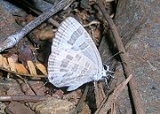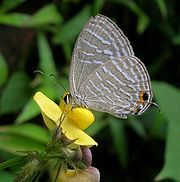
Jamides celeno
Encyclopedia
The Common Cerulean is a small butterfly
found in India
belonging to the Lycaenids or Blues
family.
Like many tropical butterflies, this species shows seasonal polyphenism, with the appearance differing between adults according to the season.
narrowly edged with black that broadens very slightly towards the apex of the wing; the cilia are brownish black.
The hindwing is uniformly coloured, except for an anticiliary black line faintly edged on the inner side by a white line within which and touching it is a row of black spots, the anterior spots very faint, the spot in interspace 2 large and well-defined, two geminate spots in interspace 1 and a very small black lunular dot in interspace 1a; cilia brown, white at the base in the interspaces. In specimens obtained in the height of the dry season the black edging to the termen
of the fore wing is much reduced and the subterminal series of black spots in the hind wing is altogether missing.
_in_talakona_forest,_ap_w_img_8499.jpg) The underside is greyish brown. The forewing has seven transverse white bands as follows:—two short bands one each side of the discocellulars, the inner one continued downwards to vein 1 and both represented at the costa by two detached spots; two parallel discal bands, the inner one broken at and the outer one terminating on vein 3; two parallel subterminal bands, the outer one slightly lunular; lastly, a more slender terminal band followed by an anticiliary slender black line; the dorsal margin narrowly white; cilia brownish black, their bases white in the interspaces. Hind wing: crossed by nine white bands or lines as follows :—three between base of wing and apex of cell, those posteriorly in interspace 1 or on vein 1 abruptly turn upwards and terminate on the dorsum ; the first band beyond the cell extends from vein 6 to vein 2, then curves upwards in interspace 1; the next extends straight from just below the costa to vein 4, thus overlapping the previous band for a short distance ; the next or postdiscal band runs between the costa and vein 3, the subterminal two also between the costa and vein 3 but the inner one of the two bands is extended down to interspace 1 and there curves upwards towards the dorsum ; both the subterminal bands are more or less lunular; in the interspace below vein 2 is a large subterminal black spot speckled with metallic blue scales and bordered inwardly by ochraceous orange; there are also in interspaces la and 1 two black dots inwardly edged by a short white streak set in an ochraceous background ; lastly, there is a complete terminal white line followed by a black anticiliary line and a filamentous short black white-tipped tail at apex of vein 2 ; cilia as on the upperside. Antennae brownish black, the shafts as usual tinged with white; head, thorax and abdomen pale brown, bluish on thorax and base of abdomen; beneath : the palpi, thorax and abdomen white, the third joint of the palpi and the second joint anteriorly black.
The underside is greyish brown. The forewing has seven transverse white bands as follows:—two short bands one each side of the discocellulars, the inner one continued downwards to vein 1 and both represented at the costa by two detached spots; two parallel discal bands, the inner one broken at and the outer one terminating on vein 3; two parallel subterminal bands, the outer one slightly lunular; lastly, a more slender terminal band followed by an anticiliary slender black line; the dorsal margin narrowly white; cilia brownish black, their bases white in the interspaces. Hind wing: crossed by nine white bands or lines as follows :—three between base of wing and apex of cell, those posteriorly in interspace 1 or on vein 1 abruptly turn upwards and terminate on the dorsum ; the first band beyond the cell extends from vein 6 to vein 2, then curves upwards in interspace 1; the next extends straight from just below the costa to vein 4, thus overlapping the previous band for a short distance ; the next or postdiscal band runs between the costa and vein 3, the subterminal two also between the costa and vein 3 but the inner one of the two bands is extended down to interspace 1 and there curves upwards towards the dorsum ; both the subterminal bands are more or less lunular; in the interspace below vein 2 is a large subterminal black spot speckled with metallic blue scales and bordered inwardly by ochraceous orange; there are also in interspaces la and 1 two black dots inwardly edged by a short white streak set in an ochraceous background ; lastly, there is a complete terminal white line followed by a black anticiliary line and a filamentous short black white-tipped tail at apex of vein 2 ; cilia as on the upperside. Antennae brownish black, the shafts as usual tinged with white; head, thorax and abdomen pale brown, bluish on thorax and base of abdomen; beneath : the palpi, thorax and abdomen white, the third joint of the palpi and the second joint anteriorly black.
The female has the upperside ground-colour paler than in the male, often quite white; terminal black edging to fore wing very much broader, broadest at apex, its margin there diffuse. Hind wing: differs from that of the male as follows:—costal margin broadly dusky black; a postdiscal transverse series of dusky-black connected lunules often more or less obsolescent; this is followed by a series of black spots each set in a background of the white ground-colour; an anticiliary slender black line as in the male. The underside ground-colour is paler than in the male, the markings however are identical. Antenna, head, thorax and abdomen as in the male.

identifies the plant on which the larva feeds in Calcutta as Heynea trijuga, Roxburgh." (de Niceville quoted by Bingham)
Other food plants noted include Atylosia albicans.
quoted by Bingham)
Butterfly
A butterfly is a mainly day-flying insect of the order Lepidoptera, which includes the butterflies and moths. Like other holometabolous insects, the butterfly's life cycle consists of four parts: egg, larva, pupa and adult. Most species are diurnal. Butterflies have large, often brightly coloured...
found in India
India
India , officially the Republic of India , is a country in South Asia. It is the seventh-largest country by geographical area, the second-most populous country with over 1.2 billion people, and the most populous democracy in the world...
belonging to the Lycaenids or Blues
Lycaenidae
The Lycaenidae are the second-largest family of butterflies, with about 6000 species worldwide, whose members are also called gossamer-winged butterflies...
family.
Description
- See glossaryGlossary of Lepidopteran termsThis glossary describes the terms used in the formal descriptions of insect species, jargon used mostly by professionals or entomologist....
for terms used
Like many tropical butterflies, this species shows seasonal polyphenism, with the appearance differing between adults according to the season.
Dry-season brood
Male upperside has the ground colour pale bluish white. The forewing has the terminal marginGlossary of Lepidopteran terms
This glossary describes the terms used in the formal descriptions of insect species, jargon used mostly by professionals or entomologist....
narrowly edged with black that broadens very slightly towards the apex of the wing; the cilia are brownish black.
The hindwing is uniformly coloured, except for an anticiliary black line faintly edged on the inner side by a white line within which and touching it is a row of black spots, the anterior spots very faint, the spot in interspace 2 large and well-defined, two geminate spots in interspace 1 and a very small black lunular dot in interspace 1a; cilia brown, white at the base in the interspaces. In specimens obtained in the height of the dry season the black edging to the termen
Glossary of Lepidopteran terms
This glossary describes the terms used in the formal descriptions of insect species, jargon used mostly by professionals or entomologist....
of the fore wing is much reduced and the subterminal series of black spots in the hind wing is altogether missing.
_in_talakona_forest,_ap_w_img_8499.jpg)
The female has the upperside ground-colour paler than in the male, often quite white; terminal black edging to fore wing very much broader, broadest at apex, its margin there diffuse. Hind wing: differs from that of the male as follows:—costal margin broadly dusky black; a postdiscal transverse series of dusky-black connected lunules often more or less obsolescent; this is followed by a series of black spots each set in a background of the white ground-colour; an anticiliary slender black line as in the male. The underside ground-colour is paler than in the male, the markings however are identical. Antenna, head, thorax and abdomen as in the male.
Wet-season brood
Closely resembles the males and females of the dry-season brood; the markings are similar but the ground-colour is generally darker both on the upper and undersides, while the black edging to the fore wing and the black postdiscal and terminal markings to the hind wing on the upperside are broader and more clearly defined. Antennae, head, thorax and abdomen as in the dry-season brood.
Larva
"When full-fed just half an inch in length, of a dull reddish-green colour, thickly shagreened with minute white tubercles, scarcely, if at all, hairy; the head pale ochraceous, entirely hidden beneath the second segment; the segments increasing in width to about the fifth, the two anal segments slightly decreasing and above flattened, especially the thirteenth; the erectile organs very small; a dorsal pulsating line, somewhat darker than the rest of the body; a subdorsal series of pale green oblique streaks, one on each segment on each side from the third to the eleventh segment inclusive; no other conspicuous markings. Dr. Forel has identified the ant that attends the larva in Calcutta, as Camponotus mitis, Smith. Dr. G. KingGeorge King (botanist)
Sir George King , was a British botanist appointed superintendent of the Royal Botanic Garden, Calcutta in 1871, and the first Director of the Botanical Survey of India from 1890. King was awarded the Linnean Medal in 1901....
identifies the plant on which the larva feeds in Calcutta as Heynea trijuga, Roxburgh." (de Niceville quoted by Bingham)
Other food plants noted include Atylosia albicans.
Pupa
"Of the usual Lycaenid shape, quite smooth, neither hairy nor pitted, pale ochreous greenish, the upper portions of the abdominal segments darker, covered throughout with coarse, rounded, blackish spots placed irregularly; a dorsal and a subdorsal series of similar but larger spots or blotches placed regularly. Head bluntly rounded, thorax slightly humped and constricted posteriorly, end of the abdomen rounded." (Lionel de NicevilleLionel de Nicéville
Charles Lionel Augustus de Nicéville was a curator at the Indian Museum in Calcutta . He studied the butterflies of South Asia and wrote a three volume monograph on the butterflies of India, Pakistan, Burma and Sri Lanka.Born in a noble Huguenot family, his father was a physician. He was educated...
quoted by Bingham)
External links
- Asahi Correctly determined photos of J. celeno from the PhilippinesPhilippinesThe Philippines , officially known as the Republic of the Philippines , is a country in Southeast Asia in the western Pacific Ocean. To its north across the Luzon Strait lies Taiwan. West across the South China Sea sits Vietnam...
See also
- LycaenidaeLycaenidaeThe Lycaenidae are the second-largest family of butterflies, with about 6000 species worldwide, whose members are also called gossamer-winged butterflies...
- List of butterflies of India
- List of butterflies of India (Lycaenidae)

